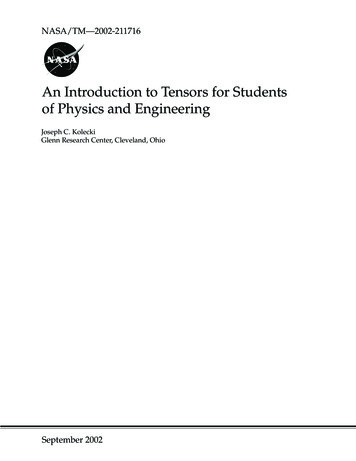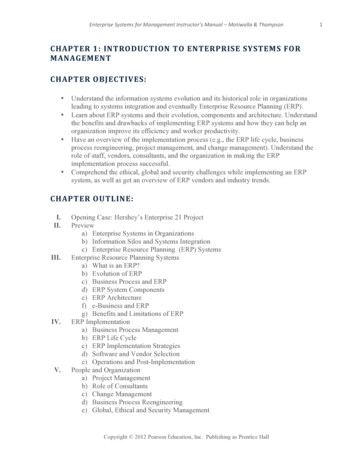
Transcription
NASA/TM—2002-211716An Introduction to Tensors for Studentsof Physics and EngineeringJoseph C. KoleckiGlenn Research Center, Cleveland, OhioSeptember 2002
The NASA STI Program Office . . . in ProfileSince its founding, NASA has been dedicated tothe advancement of aeronautics and spacescience. The NASA Scientific and TechnicalInformation (STI) Program Office plays a key partin helping NASA maintain this important role. CONFERENCE PUBLICATION. Collectedpapers from scientific and technicalconferences, symposia, seminars, or othermeetings sponsored or cosponsored byNASA.The NASA STI Program Office is operated byLangley Research Center, the Lead Center forNASA’s scientific and technical information. TheNASA STI Program Office provides access to theNASA STI Database, the largest collection ofaeronautical and space science STI in the world.The Program Office is also NASA’s institutionalmechanism for disseminating the results of itsresearch and development activities. These resultsare published by NASA in the NASA STI ReportSeries, which includes the following report types: SPECIAL PUBLICATION. Scientific,technical, or historical information fromNASA programs, projects, and missions,often concerned with subjects havingsubstantial public interest. TECHNICAL TRANSLATION. Englishlanguage translations of foreign scientificand technical material pertinent to NASA’smission. TECHNICAL PUBLICATION. Reports ofcompleted research or a major significantphase of research that present the results ofNASA programs and include extensive dataor theoretical analysis. Includes compilationsof significant scientific and technical data andinformation deemed to be of continuingreference value. NASA’s counterpart of peerreviewed formal professional papers buthas less stringent limitations on manuscriptlength and extent of graphic presentations.TECHNICAL MEMORANDUM. Scientificand technical findings that are preliminary orof specialized interest, e.g., quick releasereports, working papers, and bibliographiesthat contain minimal annotation. Does notcontain extensive analysis.CONTRACTOR REPORT. Scientific andtechnical findings by NASA-sponsoredcontractors and grantees.Specialized services that complement the STIProgram Office’s diverse offerings includecreating custom thesauri, building customizeddatabases, organizing and publishing researchresults . . . even providing videos.For more information about the NASA STIProgram Office, see the following: Access the NASA STI Program Home Pageat http://www.sti.nasa.gov E-mail your question via the Internet tohelp@sti.nasa.gov Fax your question to the NASA AccessHelp Desk at 301–621–0134 Telephone the NASA Access Help Desk at301–621–0390 Write to:NASA Access Help DeskNASA Center for AeroSpace Information7121 Standard DriveHanover, MD 21076
NASA/TM—2002-211716An Introduction to Tensors for Studentsof Physics and EngineeringJoseph C. KoleckiGlenn Research Center, Cleveland, OhioNational Aeronautics andSpace AdministrationGlenn Research CenterSeptember 2002
Available fromNASA Center for Aerospace Information7121 Standard DriveHanover, MD 21076National Technical Information Service5285 Port Royal RoadSpringfield, VA 22100Available electronically at http://gltrs.grc.nasa.gov
An Introduction To Tensorsfor Students of Physics and EngineeringJoseph C. KoleckiNational Aeronautics and Space AdministrationGlenn Research CenterCleveland, Ohio 44135Tensor analysis is the type of subject that can make even the best of students shudder. My ownpost-graduate instructor in the subject took away much of the fear by speaking of an implicitrhythm in the peculiar notation traditionally used, and helped me to see how this rhythm plays itsway throughout the various formalisms.Prior to taking that class, I had spent many years “playing” on my own with tensors. I found thegoing to be tremendously difficult, but was able, over time, to back out some physical andgeometrical considerations that helped to make the subject a little more transparent. Today, it issometimes hard not to think in terms of tensors and their associated concepts.This article, prompted and greatly enhanced by Marlos Jacob, whom I’ve met only by e-mail, isan attempt to record those early notions concerning tensors. It is intended to serve as a bridgefrom the point where most undergraduate students “leave off” in their studies of mathematics tothe place where most texts on tensor analysis begin. A basic knowledge of vectors, matrices, andphysics is assumed. A semi-intuitive approach to those notions underlying tensor analysis isgiven via scalars, vectors, dyads, triads, and similar higher-order vector products. The readermust be prepared to do some mathematics and to think.For those students who wish to go beyond this humble start, I can only recommend myprofessor’s wisdom: find the rhythm in the mathematics and you will fare pretty well.BeginningsAt the heart of all mathematics are numbers.If I were to ask how many marbles you had in a bag, you might answer, “Three.” I would findyour answer perfectly satisfactory. The ‘bare’ number 3, a magnitude, is sufficient to provide theinformation I seek.If I were to ask, “How far is it to your house?” and you answered, “Three,” however, I wouldlook at you quizzically and ask, “Three what?” Evidently, for this question, more information isrequired. The bare number 3 is no longer sufficient; I require a ‘denominate’ number – a numberwith a name.Suppose you rejoindered, “Three km.” The number 3 is now named as representing a certainnumber of km. Such numbers are sometimes called scalars. Temperature is represented by ascalar. The total energy of a thermodynamic system is also represented by a scalar.If I were next to ask “Then how do I get to your house from here?” and you said, “Just walkthree km,” again I would look at you quizzically. This time, not even a denominate number issufficient; it is necessary to specify a distance or magnitude, yes, but in which direction?NASA/TM 2002-2117161
“Just walk three km due north.” The denominate number 3 km now has the required additionaldirectional information attached to it. Such numbers are called vectors. Velocity is a vector sinceit has a magnitude and a direction; so is momentum. Quite often, a vector is represented bycomponents. If you were to tell me that to go from here to your house I must walk three blockseast, two blocks north, and go up three floors, the vector extending from “here” to “your house”would have three spatial components: Three blocks east,Two blocks north,Three floors up.Physically, vectors are used to represent locations, velocities, accelerations, flux densities, fieldquantities, etc. The defining equations of the gravitational field in classical dynamics (Newton’sLaw of Universal Gravitation), and of the electromagnetic field in classical electrodynamics(Maxwell’s four equations) are all given in vector form. Since vectors are higher order quantitiesthan scalars, the physical realities they correspond to are typically more complex than thoserepresented by scalars.A Closer Look at VectorsThe action of a vector is equal to the sum of the actions of its components. Thus, in the examplegiven above, the vector from “here” to “your house” can be represented asV 1 3 blocks east 2 blocks north 3 floors upEach component of V contains a vector and a scalar part. The scalar and vector components of Vcan be represented as follows: Scalar: Let a 3 blocks, b 2 blocks, and c 3 floors be the scalar components; and Vector: Let i be a unit vector pointing east, j be a unit vector pointing north, and k be aunit vector pointing up. (N.B.: Unit vectors are non-denominate, have a magnitude ofunity, and are used only to specify a direction.)Then the total vector, in terms of its scalar components and the unit vectors, can be written asV ai bj ck.This notation is standard in all books on physics and engineering. It is also used in books onintroductory mathematics.Next, let us look at how vectors combine. First of all, we know that numbers may be combinedin various ways to produce new numbers. For example, six is the sum of three and three or theproduct of two and three. A similar logic holds for vectors. Vector rules of combination includevector addition, scalar (dot or inner) multiplication, and (in three dimensions) crossmultiplication. Two vectors, U and V, can be added to produce a new vector W:W U V.1The appropriate symbol to use here is “ ” rather than “ ” since the ‘equation’ is not a strict vectoridentity. However, for the sake of clarity, the “ ” notation has been suppressed both here and later on,and “ ” signs have been used throughout. There is no essential loss in rigor, and the meaning should beclear to all readers.NASA/TM 2002-2117162
Vector addition is often pictorially represented by the so-called parallelogram rule. This rule is apencil and straightedge construction that is strictly applicable only for vectors in Euclideanspace, or for vectors in a curved space embedded in a Euclidean space of higher dimension,where the parallelogram rule is applied in the higher dimensional Euclidean space. For example,two tangent vectors on the surface of a sphere may be combined via the parallelogram ruleprovided that the vectors are represented in the Euclidean 3-space which contains the sphere. Informal tensor analysis, such devices as the parallelogram rule are generally not considered.Two vectors, U and V can also be combined via an inner product to form a new scalar η. ThusU · V η.Example: The inner product of force and velocity gives the scalar power being delivered into (orbeing taken out of) a system:f(nt) · v(m/s) p(W).Example: The inner product of a vector with itself is the square of the magnitude (length) of thevector:U · U U2.Two vectors U and V in three-dimensional space can be combined via a cross product to form anew (axial) vector:U V Swhere S is perpendicular to the plane containing U and V and has a sense (direction) given by theright-hand rule.Example: Angular momentum is the cross product of linear momentum and distance:p(kg m/s) s(m) L(kg m2/s).Finally, a given vector V can be multiplied by a scalar number α to produce a new vector with adifferent magnitude but the same direction. Let V Vu where u is a unit vector. ThenαV αVu (αV)u ξuwhere ξ is the new magnitude.Example: Force (a vector) equals mass (a scalar) times acceleration (a vector):f(nt) m(kg) a(m/s2)where the force and the acceleration share a common direction.Introducing Tensors: Magnetic Permeability and Material StressWe have just seen that vectors can be multiplied by scalars to produce new vectors with the samesense or direction. In general, we can specify a unit vector u, at any location we wish, to point inany direction we please. In order to construct another vector from the unit vector, we multiply uby a scalar, for example λ, to obtain λu, a new vector with magnitude λ and the sense ordirection of u.NASA/TM 2002-2117163
Notice that the effect of multiplying the unit vector by the scalar is to change the magnitude fromunity to something else, but to leave the direction unchanged. Suppose we wished to alter boththe magnitude and the direction of a given vector. Multiplication by a scalar is no longersufficient. Forming the cross product with another vector is also not sufficient, unless we wish tolimit the change in direction to right angles. We must find and use another kind of mathematical‘entity.’Let’s pause to introduce some terminology. We will rename the familiar quantities of theprevious paragraphs in the following way: Scalar: Tensor of rank 0.Vector: Tensor of rank 1.(magnitude only – 1 component)(magnitude and one direction – 3 components)This terminology is suggestive. Why stop at rank 1? Why not go onto rank 2, rank 3, and so on. Dyad: Tensor of rank 2.Triad: Tensor of rank 3.Etcetera (magnitude and two directions – 32 9 components)(magnitude and three directions – 33 27 components)We will now merely state that if we form the inner product of a vector and a tensor of rank 2,adyad, the result will be another vector with both a new magnitude and a new direction. (We willconsider triads and higher order objects later.)A tensor of rank 2 is defined as a system that has a magnitude and two directions associated withit. It has 9 components. For now, we will use an example from classical electrodynamics toillustrate the point just made.The magnetic flux density B in volt-sec/m2 and the magnetization H in Amp/m are relatedthrough the permeability µ in H/m by the expressionB µH.For free space, µ is a scalar with value µ ( µ0) 4π 10-7 H/m. Since µ is a scalar, the fluxdensity and the magnetization in free space differ in magnitude but not in direction. In someexotic materials, however, the component atoms or molecules have peculiar dipole propertiesthat make these terms differ in both magnitude and direction. In such materials, the scalarpermeability is then replaced by the tensor permeability µ, and we write, in place of the aboveequation,B µ · H.The permeability µ is a tensor of rank 2. Remember that B and H are both vectors, but they nowdiffer from one another in both magnitude and direction.The classical example of the use of tensors in physics has to do with stress in a material object.Stress has the units of force-per-unit-area, or nt/m2. It seems clear, therefore, that (stress) (area) should equal (force); i.e., the stress-area product should be associated with the appliedforces that are producing the stress. We know that force is a vector. We also know that area canbe represented as a vector by associating it with a direction, i.e., the differential area dS is avector with magnitude dS and direction normal to the area element, pointing outward from theconvex side.NASA/TM 2002-2117164
Thus, the stress in the equation (force) (stress) (area) must be either a scalar or a tensor. Ifstress were a scalar, then a single denominate number should suffice to represent the stress at anypoint within a material. But an immediate problem arises in that there are two different types ofstress: tensile stress (normal force) and shear stress (tangential force). How can a singledenominate number represent both? Additionally, stresses have directional properties more like“vector times vector” (or dyad) than simply “vector.” We must conclude that stress is a tensor –it is, in fact, another tensor of rank 2 – and that the force must be an inner product of stress andarea.The force dF due to the stress T acting on a differential surface element dS is thus given bydF T · dS.The right-hand side can be integrated over any surface within the material under consideration,as is actually done, for example, in the analysis of bending moments in beams. The stress tensorT was the first tensor to be described and used by scientists and engineers. The word tensorderives from the Latin tensus meaning stress or tension.In summary, notice that in the progression from single number to scalar to vector to tensor, etc.,information is being added at every step. The complexity of the physical situation being modeleddetermines the rank of the tensor representation we must choose. A tensor of rank 0 is sufficientto represent a single temperature or a temperature field across a surface, for example, an aircraftcompressor blade. A tensor of rank 1 is required to represent the electric field surrounding apoint charge in space or the gravitational field of a massive object. A tensor of rank 2 isnecessary to represent a magnetic permeability in complex materials, or the stresses in a materialobject or in a field, and so on.Preliminary Mathematical ConsiderationsLet’s consider the dyad – the “vector times vector” product mentioned above – in a little moredetail. Dyad products were the mathematical precursors to actual tensors, and, although they aresomewhat more cumbersome to use, their relationship with the physical world is somewhat moreintuitive because they directly build from more traditional vector concepts understood byphysicists and engineers.In constructing a dyad product from two vectors, we form the term-by-term product of each oftheir individual components and add. If U and V are the two vectors under consideration, theirdyad product is simply UV. The dyad product UV is neither a dot nor a cross product. It is adistinct entity unto itself. If U u1i u2j u3k and V v1i v2j v3k, thenUV u1v1ii u1v2ij u1v3ik u2v1ji · ··where i, j, and k are unit vectors in the usual sense and ii, ij, ik, etc. are unit dyads. In formingthe product UV above, we simply “did what came naturally” (a favorite phrase of another of myprofessors!) from our knowledge of multiplying polynomials in elementary algebra. Notice that,by setting u1v1 µ11, u1v2 µ12, etc., this dyad can be rewritten asUV µ11ii µ12ij µ13ik µ21ji · ··and that the scalar components µij can be arranged in the familiar configuration of a 3x3 matrix:µ11 µ12 µ13µ21 µ22 µ23NASA/TM 2002-2117165
µ31 µ32 µ33All dyads can have their scalar components represented as matrices. Just as a given matrix isgenerally not equal to its transpose, so with dyads it is generally the case that UV VU, i.e., thedyad product is not commutative.We know that a matrix can be multiplied by another matrix or by a vector. We also know that,given a matrix, the results of pre- and post-multiplication are usually different; i.e., matrixmultiplication does not, in general, commute. This property of matrices is used extensively inthe “bra-“ and “ket-“ formalisms of quantum mechanics.Using the known rules of matrix multiplication, we can, by extension, write the rules associatedwith dyad multiplication.The product of a matrix M and a scalar α is commutative. Let the scalar components of M berepresented by the 3 3 matrix [µij] i, j 1, 2, 3; (i.e., the scalar components of M can bethought of as the same array of numbers shown above). Then for any scalar α, we findαM [αµij] [µijα] Mα.Similarly, the product of a dyad UV and a scalar α is defined asα(UV) (αU)V (Uα)V U(αV) U(Vα) (UV)α.In this case, the results of pre- and post-multiplication are equal.The inner product of a matrix and a vector, however, is not commutative. Let V (Vi) be arow vector with i 1, 2, 3, and M [µij] as before. Then, when we pre-multiply,U V · M (Uj) [Σ i Vi µij]where the summation is over the first matrix index i.When we post-multiply with V (Vj) now re-arranged as a column vector,U* M · V (U*i) [Σ j µij Vj]where the summation is over the second matrix index j. It is clear that U* U.Similarly, the inner product of the dyad UV with another vector S is defined to beS · (UV)when we pre-multiply, and(UV) · Swhen we post-multiply. As with matrices, pre- and post-multiplication do make a difference tothe resulting object. To maintain consistency with matrix-vector multiplication, the dot“attaches” as follows:S · UV (S · U)V σVwhere σ S · U. The result is a vector with magnitude σ and sense (direction) determined by V.ButNASA/TM 2002-2117166
UV · S U(V · S) Uλ λUis a vector with magnitude λ and sense determined by U. It should be clear that, in general,S · UV UV · S.Tensors of Rank 2Tensors of rank 2 result from dyad products of vectors. In an entirely analogous way, tensors ofrank 3 arise from triad products, UVW, and tensors of rank n arise from “n-ad” products ofvectors, UVW.AB. In three-dimensional space, the number of components in each of thesesystems is 3n. The rules governing these higher rank objects are defined in the same way as therules developed above.Specific Statements for Tensors per seWe now extend the properties and rules of operation for familiar objects – scalars, vectors, andmatrices – to tensors per se. We will summarize our previous remarks in Items 1–5 and thenmake definitive statements explicitly for tensors in Items 6–12.1. All scalars are not tensors, although all tensors of rank 0 are scalars (see below).2. All vectors are not tensors, although all tensors of rank 1 are vectors (see below).3. All dyads or matrices are not tensors, although all tensors of rank 2 are dyads ormatrices.4. We have examined, in some detail, properties and operating rules for scalars, vectors,dyads, and matrices.5. We now extend these rules to tensors per se. We assert that:6. Tensors can be multiplied by other tensors to form new tensors.7. The product of a tensor and a scalar (tensor of rank 0) is commutative.8. The pre-multiplication of a given tensor by another tensor produces a different resultfrom post-multiplication; i.e., tensor multiplication in general is not commutative.9. The rank of a new tensor formed by the product of two other tensors is the sum of theirindividual ranks.10. The inner product of a tensor and a vector or of two tensors is not commutative.11. The rank of a new tensor formed by the inner product of two other tensors is the sum oftheir individual ranks minus 2.12. A tensor of rank n in three-dimensional space has 3n components.Re-examining Magnetic Permeability and Material StressNow we can see why the magnetic permeability (the stress in a material object) must be a rank 2tensor. In this section and the next, we will use a more formal approach, proceeding more in thestyle of a mathematician writing a proof than a physicist or engineer solving a problem. Whilethe approach is formal, the conclusions are physically as well as mathematically valid.Let’s begin with the magnetic field. We use the tensor formB µ·Hand represent the tensor permeability by a dyad µ UV without concern for the specific naturesof the vectors U and V. This step is perfectly valid. Even though we cannot specify the exactNASA/TM 2002-2117167
physical natures of U and V, we understand that a second rank tensor and a dyad are equivalentprovided the vectors U and V are appropriately chosen. We make this assumption without loss ofgenerality. From the physicist/engineer perspective, it is only significant that the dyad UV represents a physical quantity – i.e., permeability µ; andthe rules developed in the previous section can be applied to the dyad representation in astrictly formalistic way to advance the argument at hand.With these ideas in mind, we writeB UV · H U(V · H) Uλ λUwhere λ V · H is a scalar and U a vector. It is clear that the direction of B depends only on thedirection of U, not H. Since we specified nothing about the nature of U, U cannot be restricted inits magnitude or direction by H in any way. Therefore, we conclude that the direction of B mustbe independent of the direction of H.In tensor (or, in this case, matrix) notation, we might represent the scalar components of themagnetization vector by Hi and the permeability scalar components by a Cartesian matrix µst.The flux density then becomes a Cartesian vector whose scalar components are Bs whereBs Σt µst Htwith summation occurring over the repeated index, t. This last representation has become thestandard in the literature.Similarly, if we represent material stress as a dyad, for example, T UV (again, without concernfor the specific nature of U and V), then the inner product T · dS, can be represented asT · dS (UV) · dS U(V · dS) U dζwhere dζ is the scalar differential resulting from the inner product V · dS. The term U dζ is avector (tensor of rank 1) and is, in fact, the differential force dF acting on the area elementU dζ dF.Changing Tensor Rank: ContractionIt is inevitable in an article of this type that we must do some mathematics. The previous sectionused a more formal (less intuitive) approach to demonstrate one role that tensors play in physicsand engineering. In this section, we will stay with the formal approach and define yet another,perhaps somewhat peculiar, tensor operation, which will be left without much physical (intuitive)consideration. The student, who so wishes, can skip over this section without loss.We begin by summarizing the relationship between the type of vector product being used and therank of the resulting object. These results are already implicit in the material given above. A vector-scalar product results in a vector: there is no change in rank.A vector-vector dyad product results in a dyad: there is an increase in rank from rank 1(vector) to rank 2.A vector-vector inner product usually results in a scalar: there is a decrease in rank fromrank 1 (vector) to rank 0 (scalar).And so on.NASA/TM 2002-2117168
Except for the inner product, the rank of the resulting quantity is the sum of the ranks of thequantities being combined. So, if we form a triad UVW, its components comprise a tensor ofrank 3. If we form a “tetrad,” its components comprise a tensor of rank 4. And so on.Now it is time to introduce that “somewhat peculiar” new rule. Please rest assured that itspractical usefulness is fully attested in all of the advanced works in physics and engineeringwhere tensors are applied.Let’s say that we have a vector “n-ad,”UVW.ABCn vectorsWe can form a new tensor by introducing a dot between any two consecutive terms. Thus, wemight choose to introduce a dot between U and V, or V and W, etc. This process is calledcontraction, and results in a new tensor with rank (n – 2). If we introduce a dot into an existing dyad, the dyad is contracted to a scalar. Thus, giventhe dyad UV, we can introduce the dot forming a new tensor U · V, which is a scalar.And there is a reduction in rank by two. A special case of interest is the dyad UU.Contraction of the dyad gives the squared magnitude of the vector U: U · U U2. If we introduce a dot into an existing triad, the triad is contracted to a vector. Given thetriad UVW, we can introduce a dot in one of two ways, forming either U · VW or UV ·W, either of which is a vector, sinceU · VW (U · V)W αW where (α U · V)orUV · W U(V · W) (V · W)U βU where (β V · W).Notice that the two results are different – depending on the placement of the dot.Contraction of a tensor of rank (n) always results in another tensor of rank (n – 2). If we were toform the force-velocity dyad FV, as might be done in formulating the general equations of fluiddynamics, we could always find the rate of energy dissipated in the fluid (the power) bycontracting the dyad to a scalar. ThusdE/dt F · V.Essentially, given a tensor equation of rank n, it is possible to extract information from theequation in a variety of ways. The ability of tensor equations both to store information and topermit its simple manipulation should be coming clear by now!Invariance of Physical Quantities: Introducing Coordinate TransformationsTensors are typically defined by their coordinate transformation properties. The transformationproperties of tensors can be understood by realizing that the physical quantities they representmust appear in certain ways to different observers with different points of view.Suppose, for example, that I measure the temperature ( C) at a given point P at a given time. Youalso measure the temperature ( C) at P at the same time but from a different location that is inmotion relative to my location. Would it make any sense if you and I acquired differentNASA/TM 2002-2117169
magnitudes; i.e., if my thermometer measured 25 C and yours measured 125 C? No. We mustboth obtain the same quantity from our respective measurements.Put another way, suppose that I call my point of view (coordinate system or reference frame) Kand yours K*. Let T be the temperature ( C) measured at P in K and T* be the temperature ( C)measured in K*. We then requireT T*.This expression is an example of a coordinate transformation law between K and K* for thescalar temperature T. Only scalars that transform like this are to be admitted into the class oftensors of rank 0. In fact, letting T stand for any scalar quantity we wish, the equation T T* canbe taken as the definition of a tensor of rank 0.Now let T be the frequency of light emanating from a monochromatic source at P. Again, let twoobservers, K and K*, measure the frequency of the light at P at the same time using the sameunits of inverse seconds. If I am stationary relative to the source, the light will have a certainfrequency, for example T υ0. If, on the other hand, you are moving toward or away from thesource when you take your measurement, the light will be red or blue shifted with frequency T* υ0 υ. Obviously T T* in this case, and although the frequency thus observed is a scalar, itis evidently, not a tensor of rank 0.A similar argument holds for vectors. As was the case with scalars, not all vectors are tensors ofrank 1. Suppose that a vector quantity V exists at a point P. Again, assume two reference frames,K and K*. Let V be the vector observed (measured) in K, and V* be the same vector observed inK* at the same time. As with the temperature example, we again require thatV V*since, after all, K and K* are both observing the self-same vector. Any other result would notmake physical sense. Any vector that transforms according to the expression V V* is definedto be a tensor of rank 1. We usually say that the transformation law T T*, or V V*, requiresthe quantity represented by T or V to be coordinate independent.While the vector itself is coordinate independent, its individual components are not. Thus, in thevector transformation law V V*, the components of the vector vary from system to system, butdo so in such a way that the vector quantity itself remains unchanged. This truth is evident whenwe realize that the components in any coordinate system are nothing more than the projections ofthe vector onto the local coordinate axes.Many representations exist for vectors in Euclidean 3-space, the space of our school algebra andgeometry, including the familiar V α i β j γ k in which V is the vector being represented; α,β, and γ are its scala
Example: The inner product of force and velocity gives the scalar power being delivered into (or being taken out of) a system: f(nt) · v(m/s) p(W). Example: The inner product of a vector with itself is the sq











